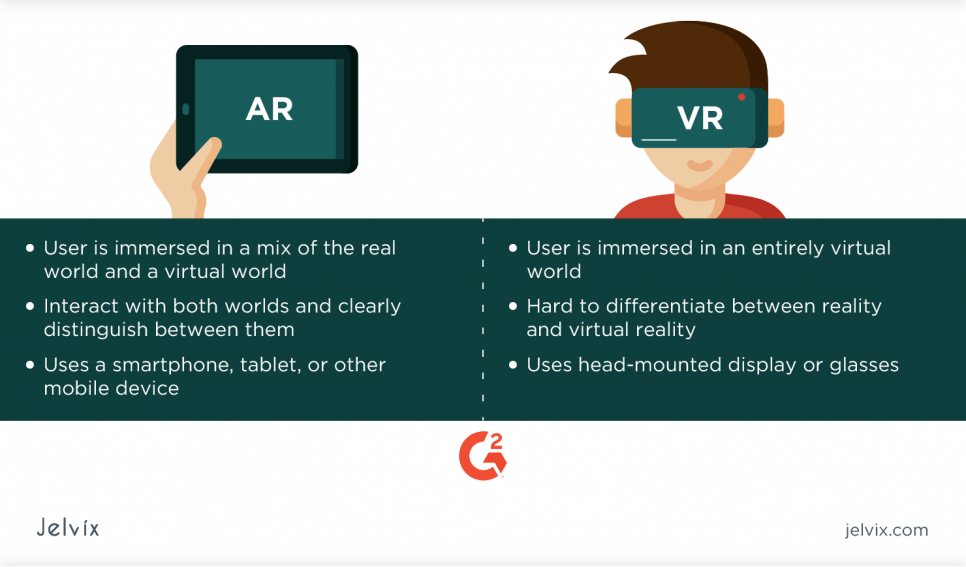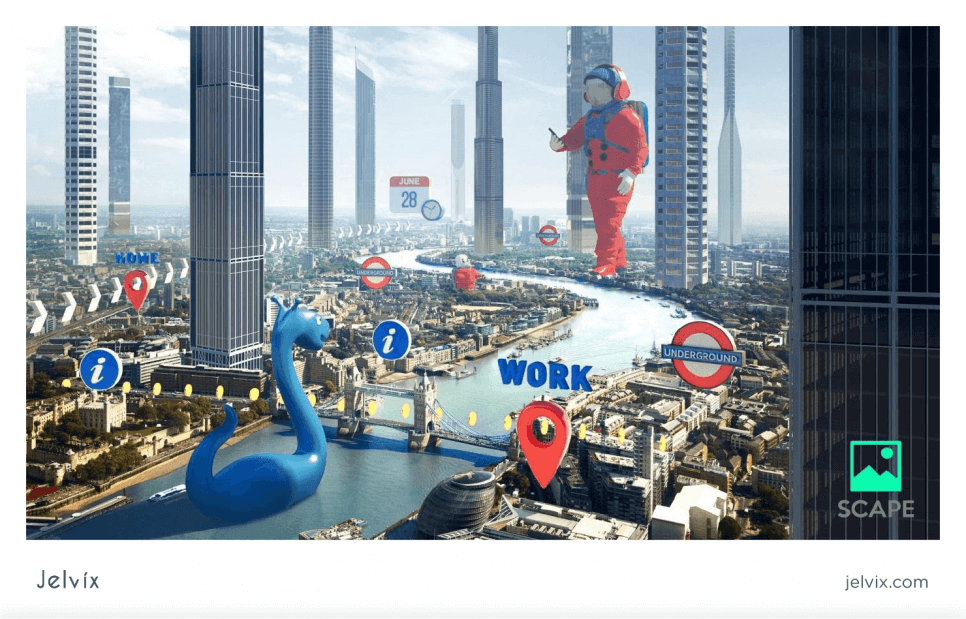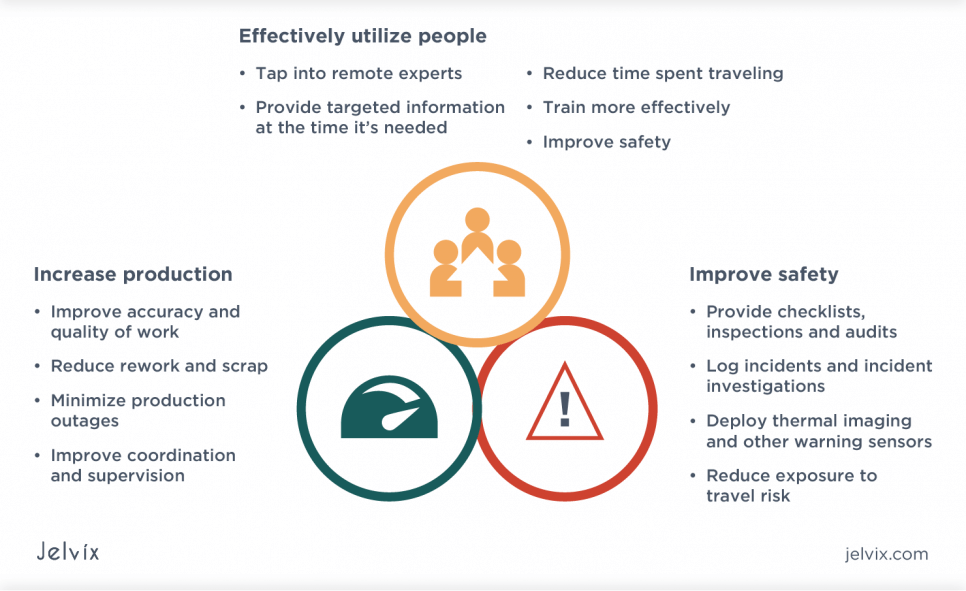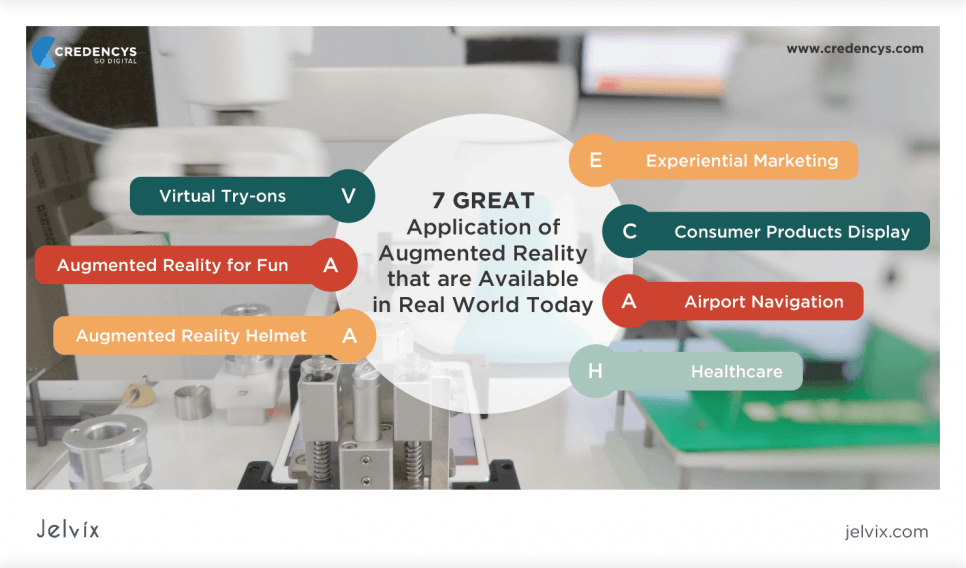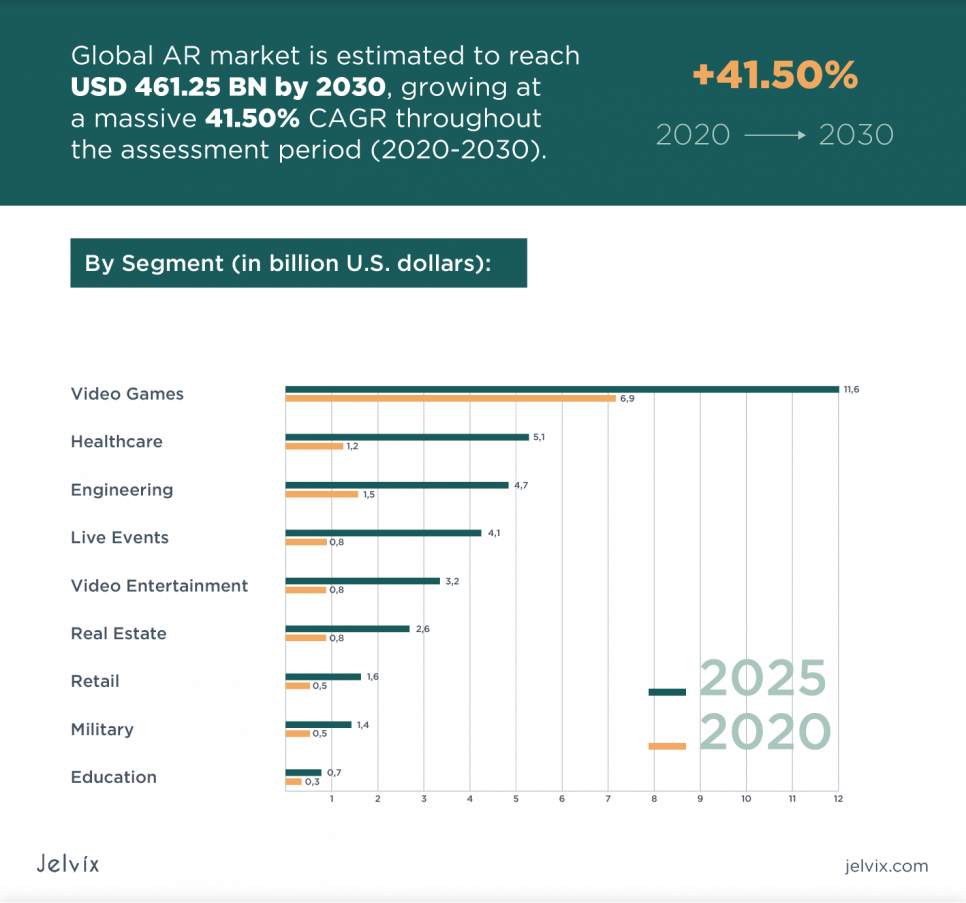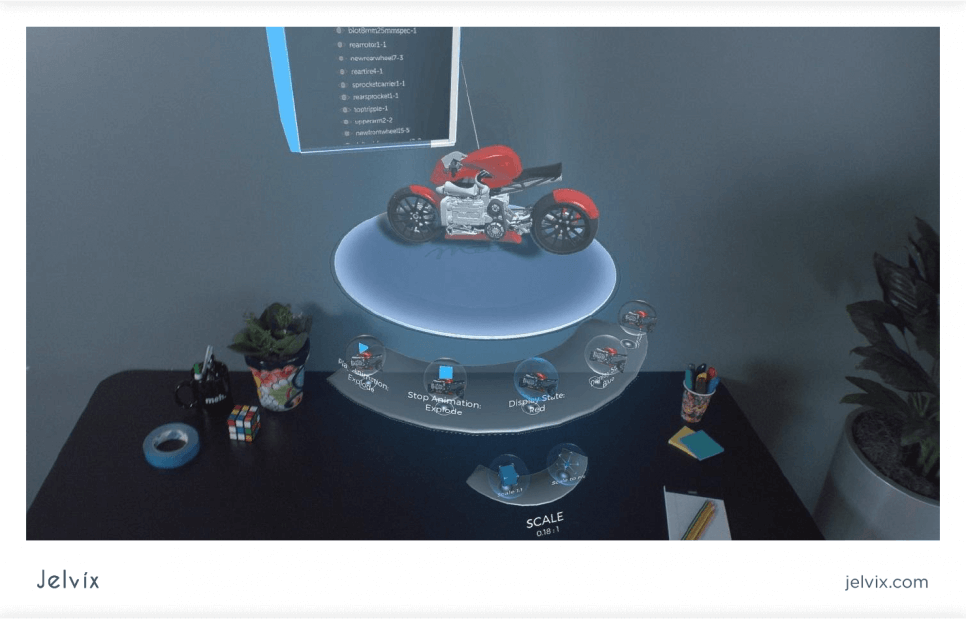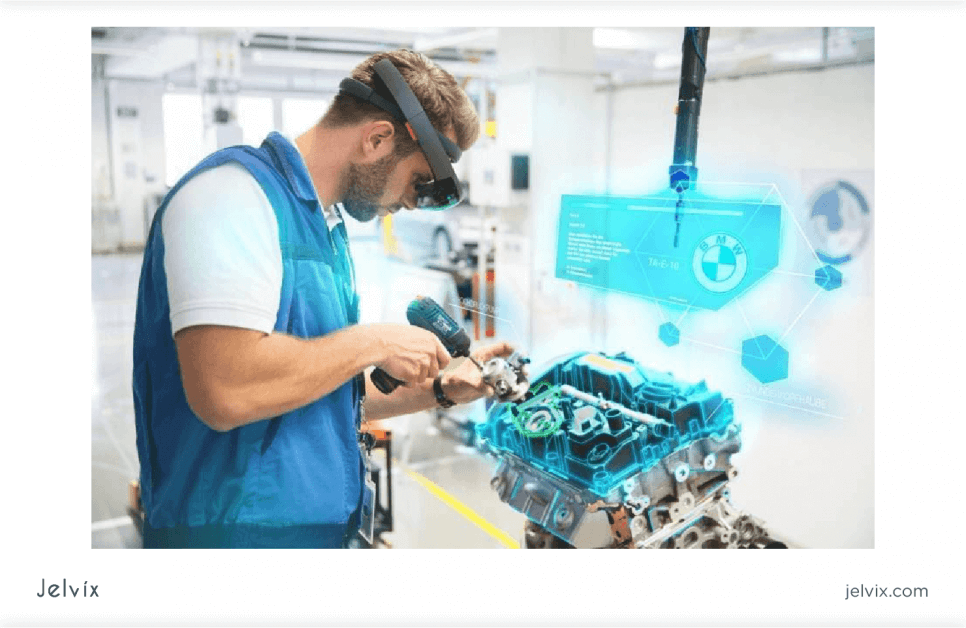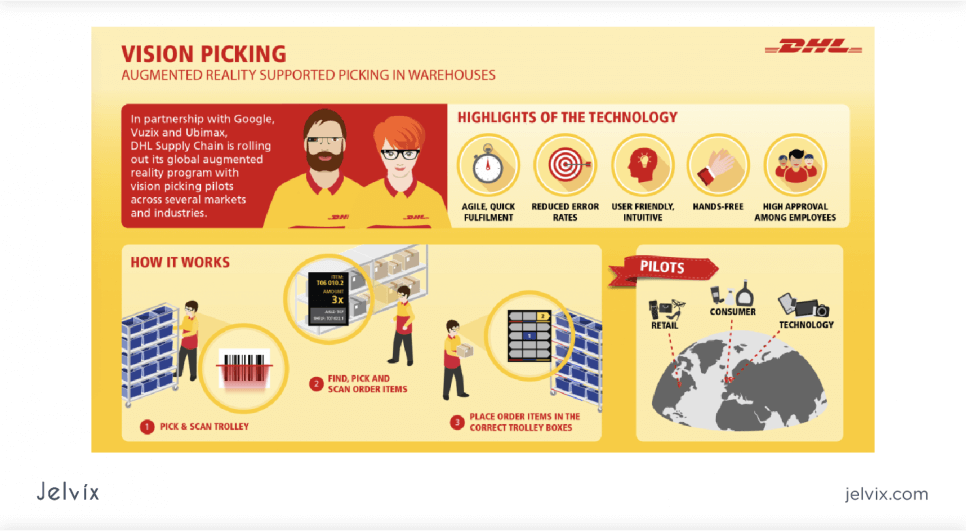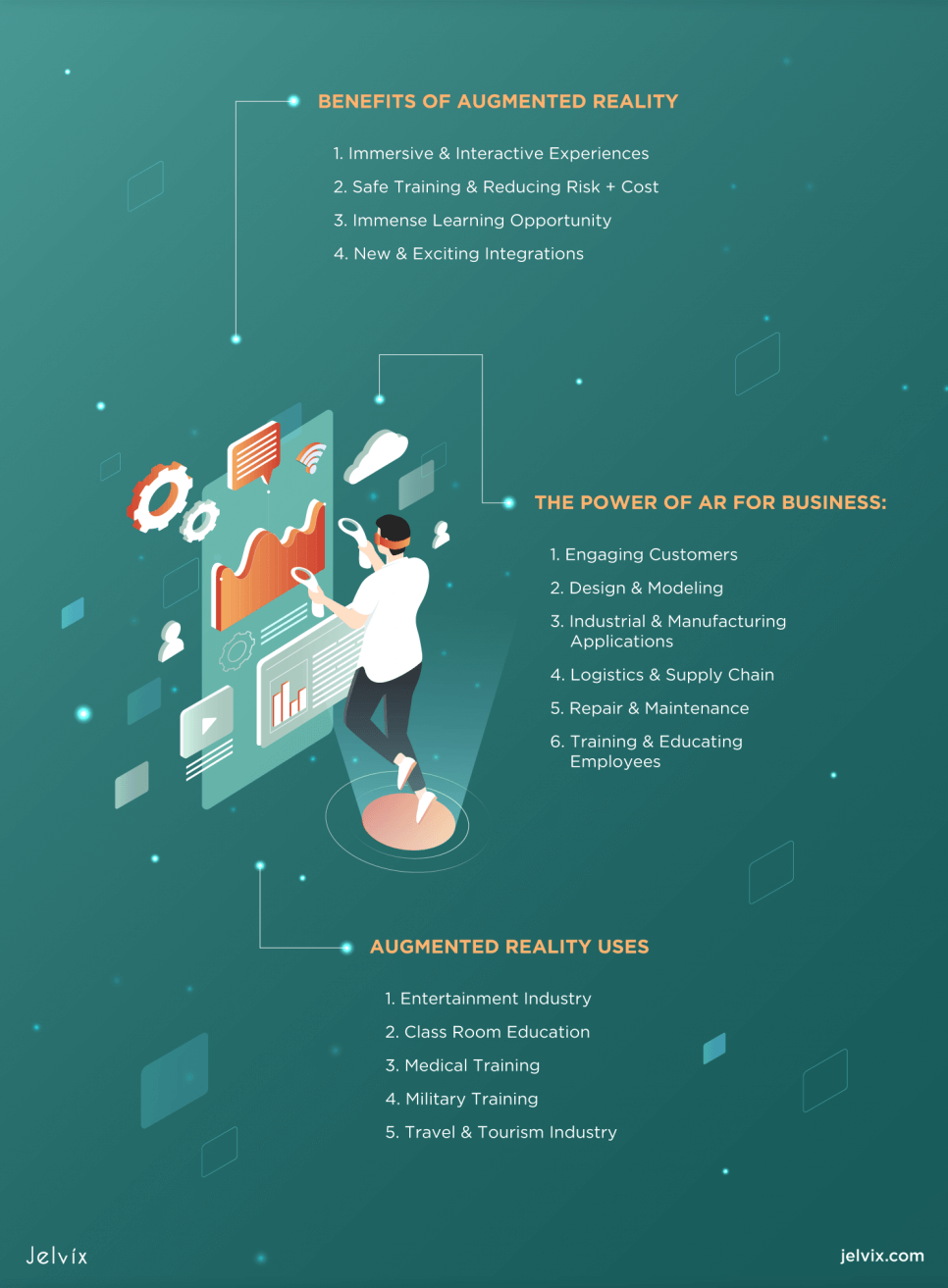Augmented reality can be defined as a technology that can offer an interactive experience of the real-world environment that delivers enhanced computer-generated perceptual information. AR is known for utilizing multiple sensory modalities such as auditory, haptic, olfactory, somatosensory, and visual systems.
It has a deep-rooted history ever since L. Frank Baum pitched the concept back in 1901, which was about an electronic display called the ‘character maker.’ Over the years, there was a lot of progress made through individual testing, and it wasn’t long before Louis Rosenberg developed an early working model for AR systems back in 1992.
Today we have major players in the market working on AR technology and further development, such as Google, Magic Leap, Microsoft, and Vuzix, to name a few. Some prominent projects include:
- Google Glass – a brand of smart glasses that serve as an optical head-mounted display currently offered only to businesses exclusively.
- Microsoft’s HoloLens – untethered mixed reality headset designed to help resolve real business problems with intelligent applications.
- Vuzix – a multinational technology firm that supplies a range of wearable display technology, including Vuzix Blade® and Vuzix M-series.
- Vuforia Augmented Reality SDK – an augmented reality software development kit for mobile devices to create AR applications.
According to a recent study by Threekit, 1% of retailers are already using AR, while 52% claim to be unprepared yet to implement the technology. On the other hand, 71% of consumers say they are more likely to shop for items if offered AR, while 40% say they would pay more for product customization through AR.
Difference between Augmented Reality and Virtual Reality
There are times when people get confused while differentiating between Augment Reality and Virtual Reality. Here are some basic differences to help you sort them out:
- While augmented reality provides the user with additional computer-generated information to enhance reality, virtual reality completely changes the user’s perception of reality through virtual information.
- In other use cases, AR can be utilized to apply digital objects into real environments; however, in VR, the entire perception of the world around them is digitized.
- AR’s fundamental difference with VR is that it adds layers of virtual objects to an actual ‘real’ surrounding. VR, on the other hand, offers an entirely virtual environment that surrounds the user’s perception.
It is important to note that AR and VR can utilize similar hardware such as head-mounted displays to offer users a unique experience. However, the majority of AR applications utilize real-world environments that are augmented through a digital interface. However, in VR, users’ experiences are heavily based on virtual environments that can only mimic real-world settings.
Benefits of Augmented Reality
Apart from business use cases, augmented reality itself holds a lot of potential to aid humans across the planet and experience a wide variety of benefits such as:
-
Immersive & Interactive Experiences
One of the most significant advantages of using AR is providing users with interactive media that can be used to build engagement and interfaces that they can interact with easily. While the development of such a technology may require painstaking efforts, the result is a user-friendly experience that people can immerse themselves in and find entertaining.
As we are human beings, our ingenuity knows no limits. Hence when people experience new environments that include augmented reality elements, it can help spark creativity. This can also be used to provide therapy for drug abuse, such as in Renew Recovery, a treatment center in Louisville, KY, that uses AR to fight alcoholism and drug addiction.
-
Safe Training & Reducing Risk + Cost
One of the greatest gifts of implementing augmented reality is that it can help reduce costs and risks associated with performing dangerous tasks in hazardous environments. A lot of people worldwide work in environments that can pose a serious risk to their health and well-being. Having augmented reality aiding them along the way, they can make better decisions and stay out of trouble.
Furthermore, augmented reality can also help employees train and learn about safety and precautions. One fine example can be taken from NASA using AR & VR to train employees. This also includes repairing equipment in outer space.
It will be easier for anyone familiar with the 2013 film ‘Gravity’ starring Sandra Bullock and George Clooney to understand how difficult and life-threatening outer space work can be, where the margin for an error is a bare minimum.
-
Immense Learning Opportunity
Without any doubt, AR holds a terrific opportunity to provide learning to people. While it isn’t quite offering a hands-on experience that can help individuals acquire new skills and sharpen their aptitudes, it is indeed considered one of the best in offering experiential learning.
Users can be facilitated through augmented reality learning by enabling them to visit locations and real-world settings to offer them additional information through augmented reality apps.
This would allow them to acquire best practices as well as become more intrigued about their subjects and topics. One fine example can be taken from Blippar, a UK-based firm, which offered Cisco workers support to install different machine parts with the help of an AR overlay on top of the actual device.
-
New & Exciting Integrations
Like with any new technology, AR can be considered for new and exciting integrations in the current technological ecosystem that we have created over the years. This can include various new integrations such as:
- Offering additional information to visitors at museums regarding art pieces, exhibitions, sculptures, and much more.
- Offering general information about the city at various pit stops and locations, including historical monuments, art galleries, restaurants, theaters, public parks, and so much more.
- Integration with existing mobile apps, releasing new updates to support AR features for older applications.
- Offering civil engineers and city officials additional information to undertake city developments and infrastructure projects.
- Helping new homeowners deploy interior designing for their apartments, properties, condos, etc.
- Teaching young kids about day to day household chores, safety & precautions for using electrical appliances, and end-user product information such as expiry dates and batch number information.
- Making books more visually appealing and showing characters performing actions, and adding more visual detail to natural storytelling elements.
Augmented Reality Technology Overview
When we overview the global Augmented Reality Industry, we find fantastic iterations of projected growth, popularity, and expansion. According to a recent study by Statista.com, the projected growth of the augmented reality market from 2017 to 2025 is estimated to be over $195 billion.
Major players in the augmented reality applications market include:
- PTC Inc. – an American computer software and services company founded in 1985, headquartered in Boston, Massachusetts.
- Lenovo – a Chinese multinational technology company founded in 1984, headquartered in Quarry Bay, Hong Kong.
- Seiko Epson – an electronics company and one of the largest manufacturers of computer printers founded in 1942 and headquartered in Suwa, Nagano, Japan.
- Wikitude GmbH – a company that designs and develops application software, founded in 2008 and located in Salzburg, Austria.
Top applications of augmented reality technology at present and in coming years include:
- Digital Marketing;
- E-commerce;
- Retail & Shopping (physical stores);
- Educational & Learning Resources;
- Geolocation & Navigational Services;
- Integration with AI (artificial intelligence) and ML (machine learning);
- Smartphone Applications (Apple’s ARKit 3.0 and Google’s ARCore).
The Power of Augmented Reality for Business
Augmented reality will have astounding breakthroughs for businesses to acquire their customers’ attention and provide them with a lasting appeal. There are various fascinating ways that augmented reality can transform how ventures do business, and as such, it will bring about major shifts in the future of consumer behavior.
Here are some ways how augmented reality can unlock the possibilities for businesses in the coming years:
-
Engaging Customers
By far, the retail industry is the most eager to deploy augmented reality applications to deliver unique and differentiated customer experiences. This will allow them to engage their clients in newfound ways and gather insights from them to further the scope of their promotional and marketing strategies.
In short, augmented reality will deliver a playground effect for customers and provide creativity in the purchase journey. This heightened customer engagement and greatly anticipated satisfaction will help achieve informed purchasing decisions and valuable insights for organizations. Some common examples from the current era include:
- Converse, an American shoe company, offers Converse Sampler App to customers.
- IKEA adopting AR technology to assist shoppers through IKEA Place, developed by Apple.
- Gap Inc. creating the ‘DressingRomm App’ for users to try out a dress in virtual mirrors.
-
Design & Modeling
Another great way businesses can utilize augmented reality is to help them in developing designs and workable models for their products. In fact, these can be taken up a notch to deliver unique solutions for businesses to deliver highly customizable duplications of their most popular items to provide personalized experiences for loyal customers. Think about promotional items and giveaways for celebrating loyal customers. Wouldn’t that be a nice touch that would grant terrific impressions? Here are some recent examples that are already putting AR to good use:
- Autodesk offers free trials for its 3D design software and various other best-selling offers for a huge variety of design and development applications. It also offers compatibility with Microsoft’s HoloLens AR technology.
- Housecraft is an application available on the Apple Store that allows your device’s camera and the power of augmented reality to place fully rendered 3D models anywhere in your world.
- Home AR Designer is a smartphone application from Elementals Studio available on the Google Play Store that you can use to configure high-quality 3D furniture models for home improvement.
-
Industrial & Manufacturing Applications
Industrial and manufacturing applications for AR include:
- Simplifying assembly line work and operations;
- Effective and efficient maintenance of equipment;
- Enhancing the productivity of workers;
- Lowering operational costs;
- Carrying out quality assurance from raw materials procurement to finished goods.
-
Logistics & Supply Chain
Applications of AR in logistics and supply chain include:
- Accessing quick information and overviews for precise planning and decision making;
- Optimizing shipments and the delivery process;
- Keeping personnel’s safety and security in check, especially in warehouses;
- AR- & VR-based predictive modeling for improving storage capacity;
- Enhancements in freight loading and unloading.
-
Repair & Maintenance
There is a variety of applications and methods through which AR can be utilized to follow up with the repair and maintenance of business equipment, machinery, and products. This can include:
- Reducing human errors, execution time, breakdowns, downtimes, and overhead costs;
- Increasing workers’ productivity, operations speed, fixed rates, compliance, and profits;
- Real-time access to data for monitoring and controlling actions and performing analytics;
- Remote assistance through detailed instructions for unfamiliar procedures.
-
Training & Educating Employees
Who can forgo the outstanding potential AR holds for training employees and offering them the opportunity to acquire new skills for professional development? Here are some use cases:
- Mimicking real-world environments and situations to provide on job and professional training;
- Delivering engaging learning experiences & affordable programs that require less space & equipment;
- Safer training that drastically reduces work-related hazards and mishaps as well as protecting the well-being of employees;
- Transforming complex and sophisticate training manuals into easy-to-digest information for workers;
- Ability to learn, re-learn, and repeat the process without incurring any additional cost or resources.
Augmented Reality Uses
Here are some common uses where augmented reality can make businesses outshine rivals and gain a competitive edge in their niche markets:
-
Entertainment Industry
People are addicted to their smartphones and computing devices, and this is where AR can be observed to have the greatest impact on people across the globe. We find movie watchers horridly securing IMAX tickets for the latest films to experience 3D entertainment. Likewise, there is a huge market out there that businesses can tap into and offer entertainment-based applications for users. Some prominent examples include:
- AR games, such as Brickscape, Harry Potter: Wizards Unite, Ingress Prime, and Jurassic World Alive;
- AR applications, such as BBC Civilizations AR, Froggipedia, Mondly, and SketchAR;
- Face filters and augmented reality picture applications;
- Augmented reality promotional ads;
- AR packaging for board games and building block toys.
-
Class Room Education
When we talk about educating and training employees, we simply cannot forget how AR holds the potential to bring improvements to classroom sessions and lessons. Some examples include:
- Providing engaging and immersive learning experience for students with tons of interactions;
- Enabling students to deepen their interest in otherwise boring and mundane tasks such as reading, working with numbers, spatial concepts, content creation, etc.;
- Allow institutions to offer field trips and exposure training for different subjects and fields of study;
- Useful learning applications, such as Anatomy 4D and Elements 4D.
-
Medical Training
Some major benefits for deploying AR for medical training include:
- Lead to better outcomes in patient care;
- Provide enhanced learning opportunities;
- Decrease the amount needed to practice;
- Increase success rates;
- Provide medical students and trainers with an outlet for assessment.
Read our overview of the best tools for augmented reality development.
-
Military Training
There is an actual initiative by the US military itself rather than a commercially available interactive feature that is using AR to train soldiers. The US Army Synthetic Training Environment (STE) team is currently developing a massive program based on virtual reality under the direct guidance of the USAASC (US Army Acquisition Support Center).
The USAAC is a part of the Assistant Secretary of the Army for Acquisition, Logistics, and Technology (ASA(ALT)) and is headquartered at Fort Belvoir, Virginia. The program will focus on the development of advanced simulation technologies that will incorporate some gaming elements and features.
However, the basic aim is to enable the highest level of warfighting readiness and provide Units and their Soldiers with valuable feedback and intelligence to train together from any part of the world.
Additionally, the STE will not only deploy virtual reality but also include a blend of other emerging technologies, including artificial intelligence, augmented reality, and big data, to name a few. This is much bigger than any game out there, in our opinion, this program takes the top spot on the list.
-
Travel & Tourism Industry
There are travel and tourism companies out there who are gradually working up to the possibilities AR holds to promulgate their business image. The Hub Hotel from Premier Inn, for instance, is a British resort that offers wall maps in its hotel rooms that are compatible with augmented reality apps. When viewed through a smartphone, these maps provide additional information that is valuable for travelers and tourists.
The Bottom Line
Augmented reality and its application for businesses are on the rise. In the coming years, we will see widespread adoption of this technology to create unique customer experiences as brands will learn to use AR to distinguish themselves among competitors.
Furthermore, AR will be used to deliver incredibly satisfying immersive experiences for users that can leave a lasting impact on audiences. Despite the progress already made in the present times, the future holds a lot of potential to use AR in different and diverse ways. Hence, there is a lot of room to explore AR’s full potential and where it could lead us in the coming years.
Claudia Jeffrey currently works as a Sr. Research Analyst & Digital Evangelist at Dissertation Assistance. This is where higher education students can acquire professional assistance from experts specializing in their field of study. During her free time, she likes to catch up on all the latest tech developments around the globe.
Need a qualified team?
Unlock new business opportunities with the first-rate dedicated development team.



